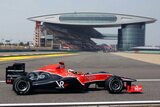
With only four rounds of the 2010 FIA Formula One World Championship remaining, Japan’s Suzuka circuit is the venue for one of the final acts in this year’s intensely fought title battle.
Five drivers – Mark Webber and Sebastian Vettel of Red Bull Racing, Lewis Hamilton and Jenson Button of McLaren and Ferrari’s Fernando Alonso – are still within 25 points of each other in the battle for the Champion’s crown. Webber leads on 202 points; Button, fifth, is on 177. Meanwhile Red Bull Racing, McLaren and Ferrari remain in a three-way tussle for the constructors’ title.
As the second of three Asian venues in the final five ‘flyaway’ grands prix, Suzuka is regarded as one of the greatest tests in Formula One. Its unique figure-of-eight layout and multiple challenging curves, which include the Esses and 130R, make Suzuka a drivers’ favourite, while also demanding the most from their machinery. The circuit’s high-speed nature rewards cars with strong aerodynamic performance and good chassis balance, as well as providing a difficult test of engine performance, on account of its marked change of gradient.
As the season approaches its conclusion, engine reliability may come to be a decisive factor in determining the outcome of the championships. Drivers are allowed only eight engines in a season before any further change incurs a 10-place grid penalty. A number of leading drivers are approaching the mileage limit of their eight permitted engines, which may soon result in lower-than-expected start positions for the title contenders.
CHANGES TO THE CIRCUIT SINCE 2009
A new 25mm negative kerb has replaced the existing kerb and the green concrete section on the exit of turns 8 and 14 has also been extended by 20 meters.
The two sections of artificial grass around the outside of turn 14 have been joined by a further section of artificial grass.
Additional artificial grass has been installed behind the kerb on the exit of turn 17 which extends twenty meters further than the existing section of green concrete.
Conveyor belt has been fitted to all tyre barriers which did not have any before.
FAST FACTS: JAPANESE GRAND PRIX
Michael Schumacher (Mercedes) will this year be attempting to win the Japanese Grand Prix for the seventh time, after his victories in 1995 (Benetton), then 1997, 2000-2002 and 2004 (all Ferrari). No other driver has won the Japanese Grand Prix more than twice.
Suzuka remains unique in Formula One in having a figure-of-eight layout: the circuit passes over itself on the approach to turn 15.
Honda-owned Suzuka was designed and built as a test track for the Japanese motor giant in 1962. It first hosted a grand prix in 1987 (an event won by Ferrari’s Gerhard Berger from pole position) and continued to do so in an unbroken sequence until 2006.
The track was designed by Dutchman John Hugenholtz, a former journalist who was director of Holland’s Zandvoort circuit from 1949 to 1974. Hugenholtz designed, and contributed to the design of a number of other circuits, including Zolder (Belgium), Jarama (Spain) and the stadium section of Germany’s Hockenheimring.
Of the 25 Japanese Grands Prix, Suzuka has hosted all but four. The first two were held at the Fuji International Speedway, as were the 2007-8 races, by which time the circuit had been extensively remodelled, to bring it into line with contemporary Formula One safety standards.
Among many notable Japanese Grands Prix are:
– 1976: James Hunt (McLaren) wins his sole world title in storm conditions after great rival Niki Lauda (Ferrari) retires. Amid the drama, Mario Andretti’s first win for Lotus is almost overlooked.
– 1987: Nelson Piquet takes his third drivers’ title after Williams team-mate Nigel Mansell crashes in practice, injuring his back and forcing him to withdraw from the race. Ferrari’s Gerhard Berger takes the team’s first win for more than two years.
– 1989: Prost vs Senna, part I. McLaren team-mates and rivals Alain Prost and Ayrton Senna collide at the chicane on lap 46. Prost retires; Senna goes on to finish first, but is later stripped of the win, handing victory to Alessandro Nannini (Benetton). Prost would win that year’s title.
– 1990: Prost vs Senna, part II. The enmity between Prost (Ferrari) and Senna (McLaren) boils over following a dispute over the positioning of the pole position start slot. A fuming Senna collides with Prost into turn 1; taking both cars out at more than 290km/h. Senna would win that year’s title.
– 1994: Damon Hill (Williams) beats arch-rival Michael Schumacher (Benetton) in a dramatic wet race that was red-flagged and re-started, with Hill winning on aggregate times. The result set up the duo’s infamous title showdown at the Australian Grand Prix seven days later.
– 2005: Kimi R?ikk?nen (McLaren) wins from 17th on the grid, after passing leader Giancarlo Fisichella (Renault) on the final lap. Fernando Alonso (Renault) also charged from 16th on the grid to third, passing Ferrari’s Michael Schumacher in a classic move around the outside of the 130R corner on lap 20.
CIRCUIT DATA
Length of lap: 5.807km
Lap record: 1:31.540 (Kimi R?ikk?nen, 2005, McLaren)
Start line/finish line offset: 0.300km
Total number of race laps: 53
Total race distance: 307.471km
Pitlane speed limits: 60km/h during practice sessions; 100km/h during qualifying and race
ADDITIONAL MEDIA OPPORTUNITIES
Qualifying: All drivers eliminated in Q1 or Q2 will be available for media interviews immediately after the end of each session as will drivers who participated in Q3, but who are not required for the post-qualifying press conference. Where? At the back of the FIA garage, paddock side.
Race: Any driver retiring before the end of the race will be available for media interviews after his return to the paddock. In addition, all drivers who finish the race outside the top three will be available for media interviews immediately after the end of the race. Where? At each team’s individual garage/hospitality or alternatively at the back of the FIA garage.
SUZUKA CIRCUIT'S LOCATION
Comments:








